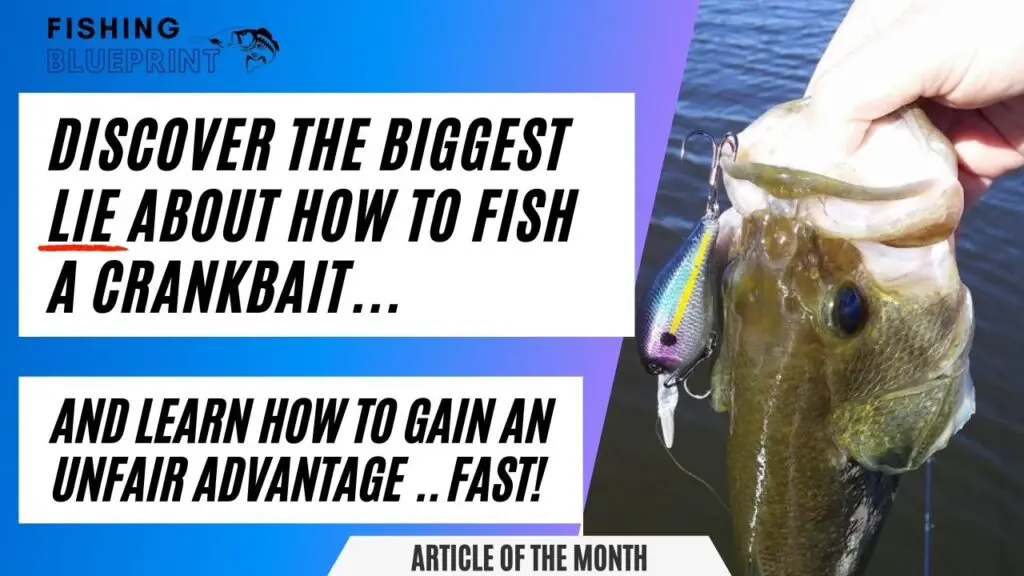How To Fish Blue Ridge Reservoir
Blue Ridge Reservoir Fishing Report
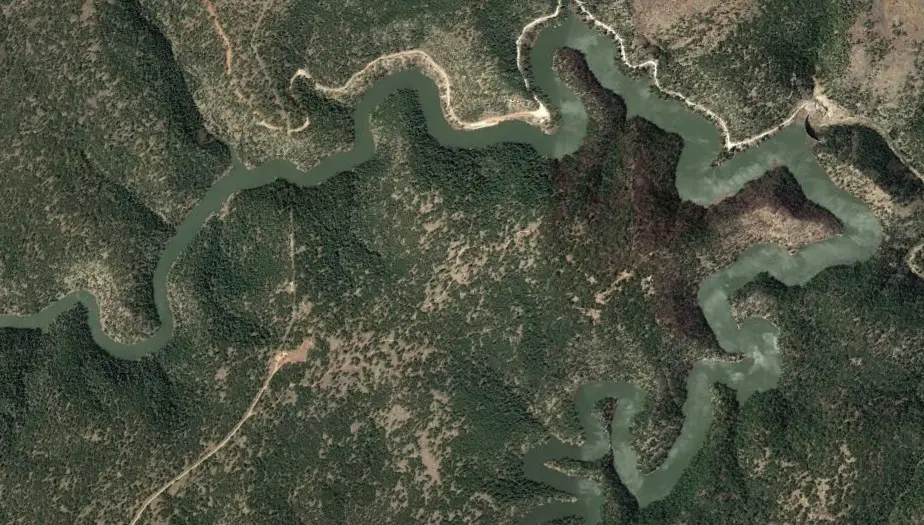
Blue Ridge Reservoir is a small lake that sits 144 miles away from Phoenix, Arizona.
Overall it’s a quiet lake being nestled in part of the northeastern part of the state on the Mogollon Rim. In this post you’re going to be given the blueprint to fish this lake.
So what are the best tips for fishing Blue Ridge Reservoir? There are three important factors you must know if you want to know how to fish Blue Ridge Reservoir successfully. First, you need to know what kind of fish is in Blue Ridge Reservoir. Second, it’s important for you to know which part of the lake each species can be found. Lastly, knowing what are the best baits that work on Blue Ridge Reservoir is vital. However, tactics, baits, and locations will be different for each type of fish that you target. So let’s talk about the steps you need to take in order to give you the best chance of catching a fish on Blue Ridge Reservoir.
WARNING: There’s a lot of information about this subject you’ll probably want to come back to. No one expects you to remember all these tips. We know your time is precious, so we really tried to over-deliver in value for you. Additionally, we frequently update reports like this, so you’ll want to stay up to date with any changes or additional tips we include for you.
We found that the easiest way to save and bookmark this report so you can come back to it later is to share it on your favorite social media platform, especially if you use your phone to get important tips like the ones in this report here…
Click on your favorite social media buttons to remember this page now!
About Blue Ridge Reservoir
If Blue Ridge Reservoir can only be described in two words they would. Absolutely gorgeous. This stunning lake sits on the Mogollon Rim in the Coconino National Forest, about halfway between Payson and Flagstaff.
Blue Ridge is a thin, long, and steep mountain range surrounded by dense forest. It has the appearance of a winding, canyon-bound river rather than a lake. One thing is certain: it is one of Arizona’s most stunning bodies of water this state has to offer.
Blue Ridge Reservoir is a deep body of water (for a Mogollon Rim lake) with the average depth being 60 feet and a maximum depth of 147 feet when the lake is completely full.
Blue Ridge Reservoir is 70 acres, is approximately 8 miles long and averages 200 feet across. This reservoir plays a vital role in snowfall runoff retention. This lake gives locals and visitors the opportunity to test their luck in catching rainbow trout, tiger trout, brown trout, sunfish, and catfish.
Important Lake Warnings
Algae blooms may be present which may affect fishing, swimming, and water contact in general.
Maximum 10-HP for gas engines on the lake.
If you are fishing and camping, fire bans may be in effect due to the ongoing drought conditions.
What Kind of Fish Are In Blue Ridge Reservoir
- Rainbow Trout
- Brown Trout
- Tiger Trout
- Sunfish
- Catfish
Blue Ridge Reservoir Fishing Tips & General Strategies
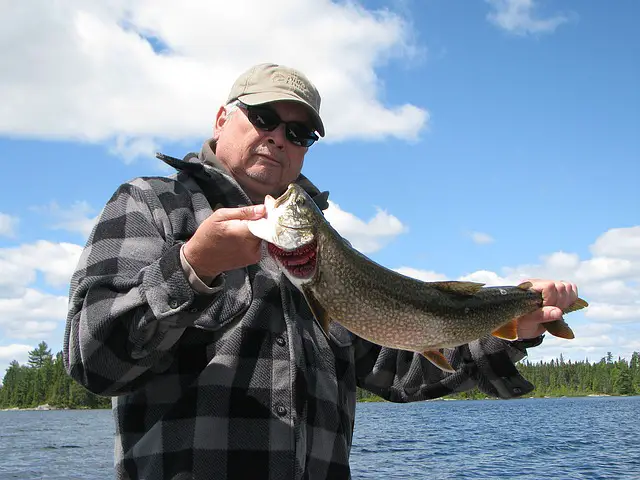
It can be a challenge to break down Blue Ridge Reservoir and decide to get started.
Getting started, Blue Ridge Reservoir is a clear water lake and fishing can be tough.
The primary structures are going to be a large creek channel that runs down the middle of the lake.
The banks vary from semi-steep to very steep. Most shoreline banks consist of chunk rock and pea-gravel and the vegetation grows right to the shoreline.
There are also standing timber, laydowns, submerged weedbeds, and reed thickets noted on the shoreline, more frequently observed in the backs of small cuts.
By far you’ll have the best opportunity to catch trout early in the morning and later in the evening.
If you fish during the day, you have luck fishing from a boat, kayak or float tube in deep water.
Trout in this lake are extremely pelagic and hunt in small schools.
You can easily fish from the shore or from a boat or kayak.
In the winter and spring, trout can be found up shallow.
Conversely in the summer, trout will often hunt in shallow water in the morning and in the evening and retreat to deep water. Overall trout prefer water temperatures that range from 55.5-56.5-degrees.
However, there is a big exception… During and right after rainstorms trout will rush to the shallows to feed on any insects that are knocked loose from the rain, and fishing can be excellent. But a word of caution, if you see lightning you must seek shelter. No fish is worth being struck by lightning.
Your best chances of catching deep suspending rainbow trout is by trolling your lure with a quality downrigger. Otherwise you can drift or slow troll trout using a fly, corn, wax worm, salmon egg, or powerbait.
This lake is absolutely beautiful, open, and accessible to nearly everybody. It’s convenient since there are paths that go along the lake’s shore.
Often you’ll hear (and maybe) see a huge herd of Elk roaming through the pine trees. In the fall you can hear them bugling.
Most of the other fish such as bluegill, and catfish will spawn in the spring.
But where are the best places to fish At Blue Ridge Reservoir?
And in no particular order here is that list of the best fishing spots at Blue Ridge Reservoir.
DISCLAIMER: The material provided is for general information purposes only. It’s important to understand that any information provided in this article can change at any time. Any maps or graphics featured are not to be used as navigational aids. Fishing Blueprint will not be responsible for any personal injury or property damage from any misuse of the maps or graphics provided. It’s completely impossible to give you every single spot where you can potentially catch a fish. But, what this list does do is to give you a helping hand and narrow down to the most productive fishing spots.
Blue Ridge Reservoir Dam

Fishing around the dam provides you access to the deepest water this lake has to offer.
If you fish from a boat or kayak, it’s important that you graph this area to see what depth the trout are holding at. Then you can easily adjust your lure depth to just above the suspending depth.
This section of the lake can get very windy. And even with the best trolling motor the wind can quickly blow you off your spot which will significantly decrease your chances of catching a fish..
That is why we strongly suggest buying a quality drift sock. For those who don’t know, a drift sock is like a parachute for the water. If it’s breezy to windy, you need to slow your drift otherwise your lure will not be in the strike zone long enough to catch a fish.
By the way, we found a really good quality drift sock made by Mythik Outdoors, and best of all they’re sold on Amazon.com. Go here to learn more about drift socks and read the reviews from actual customers.
Some of the effective baits for this area include:
But wait! Before you tie on any bait nearly every professional fishing guide will strongly encourage the use of a fish attractor like a quality flasher or dodger 2-3 feet in front of any lure. This helps get the fish’s attention, kinda like ringing a dinner bell!
Trolling spoons such as a Krocodile spoon, Super Duper, Crippled Herring, Cast Champ, or Hus-Lure. Trolling spoons have an unpredictable, minnow-like motion that delivers bone-crushing strikes. Even the slowest current brings these lures to life. Add extra motion by twitching the rod tip and enabling the bait to pop and dart forward and flutter back.
Inline spinners such as the Bang-Tail and Shyster are non-twist spinners that boast an immediate spin blade design for incredibly rapid start-ups and the best slow retrieve performance.
Many anglers also place their confidence in the Blue Fox Classic Vibrax inline spinner. This little bait is a compact shallow running lure that performs best in 2 to 6 feet of water, depending on the speed of the retrieve or trolling speed. The patented two-part body emits low-frequency sound vibrations that attract fish. This lure is best used in lakes, rivers, and streams.
Minnow style baits also work very well either cast-and-retrieved or trolled. These perform best if the water is clear/slightly stained. The Luhr-Jensen Quick Fish and the Rapala BX minnow are constructed from hard plastic, have a wide wobble action, and are extremely durable. Whereas the Rapala Original Floating Minnow and the Ultra Light Minnow (all are slow sinking) both give you a tighter wobble perfect for clear water and pressured fishing conditions.
Better yet, just buy a complete done-for-you trout lure kit!
Now if you’re fishing from the shore, kayak, or even from the shore you should also consider using these additional baits:
- Real or artificial corn – great because it will never spoil or mold over
- Natural salmon eggs – it’s hard to beat natural salmon eggs when trout are eating salmon eggs, they’ll eat up jars of this stuff!
- Artificial salmon eggs – great because they float off the bottom – ideal in rocky or grassy conditions
- Real worms – such as meal worms or nightcrawlers
- Artificial worms – great for trolling and will never die)
- Dough bait – great because they stay on the hook really well, it floats if you put enough on the hook, comes in a variety of colors and scents.
- Wet flies (sinking flies) – Wet flies imitate insects that develop and inhabit below the water level before emerging and rising to the surface.
- Woolly bugger flies – One of the most popular fly patterns ever is the Woolly Bugger. These mimic small fish, leeches, larvae, and worms.
.
Oh, before I forget, did you know that there is an article about how to troll for salmon, trout, and kokanee the right way? Go here to find out more.
If you’re fishing from the shore during the summer anywhere in this area I would strongly recommend it.
Bluegill can be caught with a simple bobber and small #12 hooks with a bread ball, corn, or even a small piece of Slim Jim (don’t laugh, it works).
Located: south end of the lake
Structural features: deep water
Best species to target: trout
Most effective way to fish this spot: boat, kayak, float tube, shoreline
Main Boat Ramp Channel
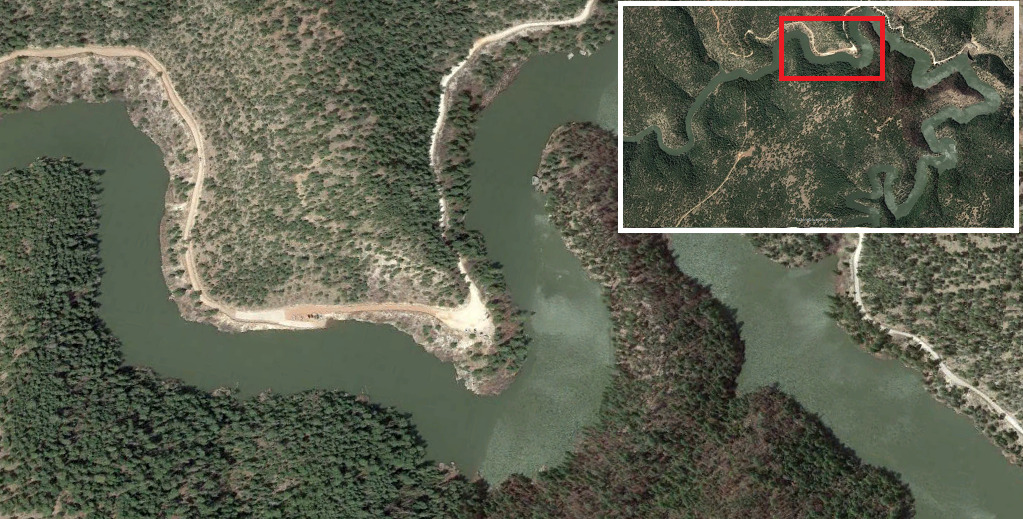
This area features a deep channel with steep rocky banks.
Trout can be caught shallow in the mornings and evenings and will retreat to deep water during midday.
You can catch sunfish and bluegill near any rocky edges, points, boulders, and vertical timber.
Some of the effective baits for this area include: Fish attractor (ie: flasher or dodger), trolling spoons, inline spinners, Rapala minnows, Quick Fish, streamers and flies. You can also use real or artificial corn, natural salmon eggs, artificial salmon eggs, real worms such as meal worms or nightcrawlers, artificial worms, and dough bait. Better yet, just buy a complete done-for-you trout lure kit!
Located: middle of the lake of the lake
Structural features: deep channel
Best species to target: trout,bluegill, catfish
Most effective way to fish this spot: boat, kayak, float tube, shoreline
Upper Creek
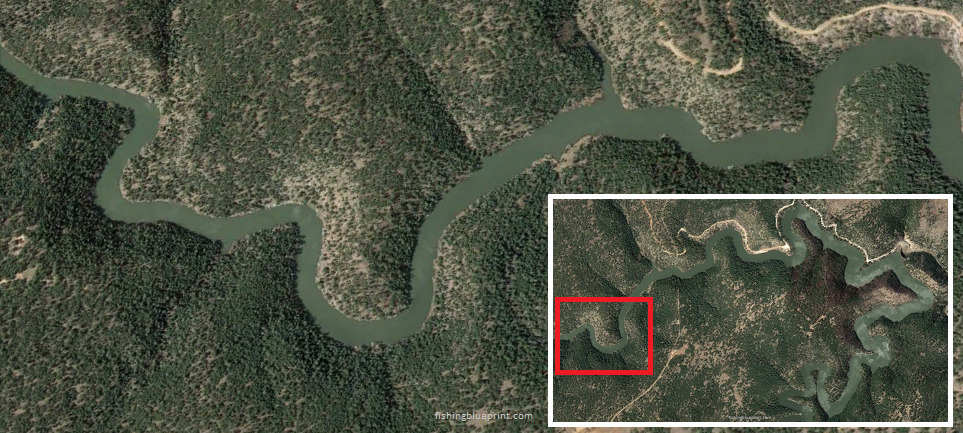
This spot is defined by a long winding channel that is narrow and relatively deep.
It has multiple points, ledges, ridges, drop offs and humps. This means you have many different structures you can target and fish.
Trout can be caught here in the winter and spring.
Some of the effective baits for this area include: Fish attractor (ie: flasher or dodger), trolling spoons, inline spinners, Rapala minnows, Quick Fish, streamers and flies. You can also use real or artificial corn, natural salmon eggs, artificial salmon eggs, real worms such as meal worms or nightcrawlers, artificial worms, and dough bait. Better yet, just buy a complete done-for-you trout lure kit!
Located: middle of the lake of the lake
Structural features: deep channel
Best species to target: trout,bluegill, catfish
Most effective way to fish this spot: boat, kayak, float tube
How To Catch Fish In Blue Ridge Reservoir
Rainbow Trout
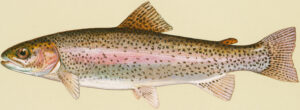 Arizona Game & Fish Department grow and stocks local lakes and reservoirs like this lake with Rainbow Trout.
Arizona Game & Fish Department grow and stocks local lakes and reservoirs like this lake with Rainbow Trout.
Due to this lake being relatively unpressured, deep, and colder, and most other desert reservoirs, the stocked trout do very well.
Since the trout are produced in local fisheries, they are healthy and have no limit on the amount of trout that can be consumed.
Typically trout are stocked twice a week, however, it can vary.
General Trout Details
Spawn: March-May
Food: insects and crustaceans.
Arizona State Record: 15 lb. 9.12 oz. 32.5 in., Willow Springs Lake Harold Wright, Sun City 9/29/06
Table Quality: Depending on the fishes diet, the meat can be white to orange-red in color. The meat is firm, flaky, and is considered excellent eating.
Angling techniques:
- Trolling with or without downriggers
- Fish attractor such as a flasher or a dodger – great when trolling.
- Trolling spoons such as a Krocodile spoon, Super Duper, Crippled Herring, Cast Champ, or Hus-Lure – simple, easy to use, can be trolled or cast-retrieved at any speed.
- Inline spinners such as the Bang-Tail and Shyster – gets a ton of bites.
- Minnow style baits such as the Luhr-Jensen Quick Fish and the Rapala BX minnow – known to hook up giant fish.
- Real or artificial corn – great because it will never spoil or mold over.
- Natural salmon eggs – it’s hard to beat natural salmon eggs at bait. When trout are eating salmon eggs, they’ll eat up a couple of jars in less than an hour!
- Artificial salmon eggs – great because they float off the bottom – ideal in rocky or grassy conditions.
- Real worms – such as meal worms or nightcrawlers.
- Artificial worms – great for trolling and will never die.
- Dry flies (floating flies) – The insects that land, float, or live on top of the water, which are represented by dry flies. Investing in a kit gives you a wide assortment of flies and a good selection of types and sizes allow you to quickly adjust to any situation.
- Wet flies (sinking flies) – Wet flies imitate insects that develop and inhabit below the water level before emerging and rising to the surface. Investing in a kit gives you a wide assortment of flies and a good selection of types and sizes allow you to quickly adjust to any situation.
- Woolly bugger flies – One of the most popular fly patterns ever is the Woolly Bugger. These mimic small fish, leeches, larvae, and worms. Investing in a kit gives you a wide assortment of flies and a good selection of types and sizes allow you to quickly adjust to any situation.
Steamer flies – They can also mimic larger animals found in streams and rivers, including crawfish, larger leeches, and smaller fish. Investing in a kit gives you a wide assortment of flies and a good selection of types and sizes allow you to quickly adjust to any situation.
- **The number one key to successful trout fishing, is to use light line (2 to 6 pound) and small hooks (10-14 sizes), and small sinkers
Brown Trout
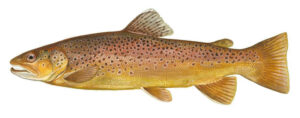 In Arizona, this is the only fish with both red and black patches on its body.
In Arizona, this is the only fish with both red and black patches on its body.
A pale/off-white halo usually surrounds dark patches on the sides.
On the back, the color ranges from dark to olive brown, dipping to yellow on the sides, and yellow or white on the belly.
In larger fish, breeding males have lower chin that will create a hooked jaw. The corner of the mouth extends past the eye, resulting in a huge mouth.
Brown trout are not native to Arizona, nor to North America for that matter. They were first imported to California in 1893 and originated in Europe.
Brown trout will commonly feed during the day if they are not bothered. Larger fish, on the other hand, are mainly nocturnal.
Brown trout are very aggressive feeders and will readily eat a streamer fly, casting upstream or into the wind.
Artificial baits such as in-line spinners or small Rapala minnow bait work phenomenally.
Live nightcrawlers, or minnows on a #6-#8 hooks are excellent baits.
If you can find any waterfall or spillway, spend some time fishing it because brown trout will often wait to ambush any prey that happens to drift over them in those areas.
Likewise, if you’re in a boat on the main lake some of the best ways to catch brown trout is to troll for these behemoths.
General Trout Details
Spawn: October-December
Food: Insects, small fish and crustaceans.
Arizona State Record: 22 lbs 14.5 oz. Caught 08/06/1999 in Reservation Lake.
Table Quality: Depending on the fishes diet, the meat can be white to orange-red in color. The meat is firm, flaky, and is considered excellent eating.
Angling techniques:
- Trolling with or without downriggers
- Fish attractor such as a flasher or a dodger – great when trolling.
- Trolling spoons such as a Krocodile spoon, Super Duper, Crippled Herring, Cast Champ, or Hus-Lure – simple, easy to use, can be trolled or cast-retrieved at any speed.
- Inline spinners such as the Bang-Tail and Shyster – gets a ton of bites.
- Minnow style baits such as the Luhr-Jensen Quick Fish and the Rapala BX minnow – known to hook up giant fish.
- Real or artificial corn – great because it will never spoil or mold over.
- Natural salmon eggs – it’s hard to beat natural salmon eggs at bait. When trout are eating salmon eggs, they’ll eat up a couple of jars in less than an hour!
- Artificial salmon eggs – great because they float off the bottom – ideal in rocky or grassy conditions.
- Real worms – such as meal worms or nightcrawlers.
- Artificial worms – great for trolling and will never die.
- Dry flies (floating flies) – The insects that land, float, or live on top of the water, which are represented by dry flies. Investing in a kit gives you a wide assortment of flies and a good selection of types and sizes allow you to quickly adjust to any situation.
- Wet flies (sinking flies) – Wet flies imitate insects that develop and inhabit below the water level before emerging and rising to the surface. Investing in a kit gives you a wide assortment of flies and a good selection of types and sizes allow you to quickly adjust to any situation.
- Woolly bugger flies – One of the most popular fly patterns ever is the Woolly Bugger. These mimic small fish, leeches, larvae, and worms. Investing in a kit gives you a wide assortment of flies and a good selection of types and sizes allow you to quickly adjust to any situation.
Steamer flies – They can also mimic larger animals found in streams and rivers, including crawfish, larger leeches, and smaller fish. Investing in a kit gives you a wide assortment of flies and a good selection of types and sizes allow you to quickly adjust to any situation.
- **The number one key to successful trout fishing, is to use light line (2 to 6 pound) and small hooks (10-14 sizes), and small sinkers
Catfish
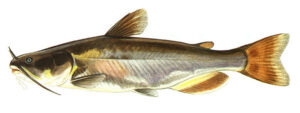
Channel catfish weight will range from 0.5-to-15-pounds in and of the Roosevelt chain lakes, including Canyon Lake. However, the average weight will be between 1-4-pounds.
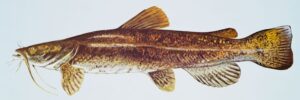
Conversely, “smaller” flathead catfish will weigh in at 15-pounds and can grow around 75-pounds. A flathead survey conducted in 2016 and 2020 caught a flathead that weighed over 48-pounds!
General Catfish Details
Spawn: March-June
Food: Carp, bluegill
Arizona State Record:
Channel catfish – 33 lb., 5.76 oz., 39.5 in., Upper Lake Mary Carson Pete, 3/26/17
Flathead catfish – 76 lb. 8.64 oz., 53.5 in., Bartlett Lake Eddie Wilcoxson, Surprise 04/13/13
Table Quality: Soft white meat. In the summer the meat will taste muddy.
Angling techniques:
Flathead catfish:
- live bait such as smaller carp, full sized bluegill, or tilapia
Channel catfish:
- chicken liver
- hotdogs
- stink bait
- small bluegill
- small carp
Bluegill/ Sunfish
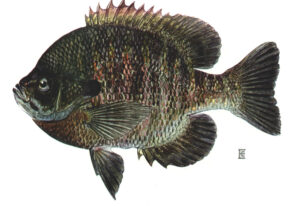 Introduced to Arizona in 1932, the bluegill has teal-blue coloring on the bottom portion of the chin and gill plate. It also has a solid black opercula flap just behind the gill plate.
Introduced to Arizona in 1932, the bluegill has teal-blue coloring on the bottom portion of the chin and gill plate. It also has a solid black opercula flap just behind the gill plate.
Bluegill are found on the shoreline and prefer nearby structures. Bluegill are incredibly aggressive and will quickly attack anything that looks like it could be eaten. Due to their aggressive behavior, they are one of the easiest fish to catch and are a great way to introduce someone to fishing.
Spawn: April and May
Food: Small fish and insects
Arizona State Record: 3 lb. 15.68 oz. 15.75 in., Goldwater Lake. Christopher Ray Mapes, Prescott Valley 5/2/04
Table Quality: Firm, white meat
Angling techniques:
- Worms
- Dough balls
- Slim jim sausages pieces on a small hook (not lying… it really works)
- Small spinners
- Trout flys
Boat Ramps At Blue Ridge Reservoir

Blue Ridge Reservoir Boat Ramp
Location: west side of the lake (follow the signs)
Phone number: none
Nearby boat ramp: 2
Groceries available: no
Gas: no
Bathrooms: yes
Showers: no
Electric: no
Camping nearby: yes
Top Tackle Shops Near Blue Ridge Reservoir
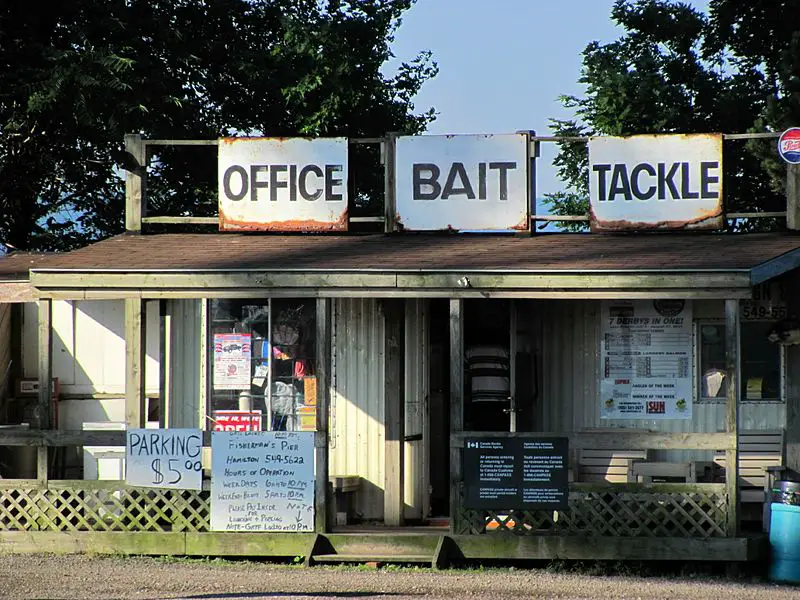
Woods Canyon Lake Store and Marina
Forest road 105, Woods Canyon Road US Highway 260, Mile Marker 282, FR 300, Forest Lakes Estates, AZ 85931
(480)586-5660
Forest Lakes General Store
2998 AZ-260, Forest Lakes Estates, AZ 85931
(928)535-4716
Ace Hardware
2837 AZ-260, Overgaard, AZ 85933
(928)535-6335
Sportsman’s Warehouse
4421 S White Mountain Rd, Show Low, AZ 85901
(928) 537-0800
White Mountain Bait & Tackle
1300 W McNeil, Show Low, AZ 85901
(928) 537-2402
M&M Kayaks
1488 E White Mountain Blvd, Pinetop, AZ 85935
(928) 358-1183
Hon Dah Ski & Outdoor Sport
787 AZ-260, Pinetop, AZ 85935
(928) 369-7669
Places to Camp, Lodging and RV parks
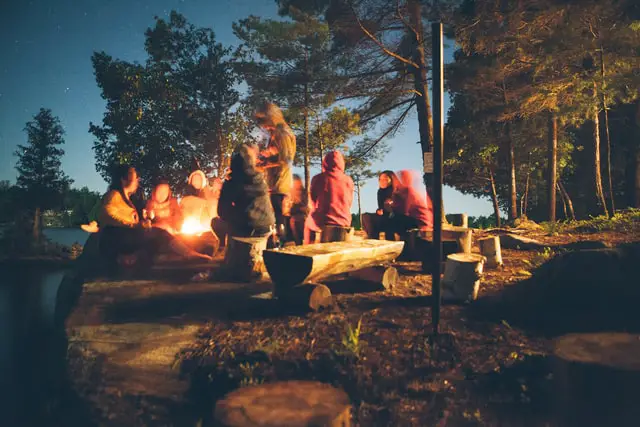
Rock Crossing Campground
- Hwy 87, Happy Jack, AZ 86024
- (928)477-2255
- Gas, phone, and groceries are available 20 miles east at Forest Lakes.
- Fees: Per USDA.gov website, “$16 per night per single unit site, up to eight people and two vehicles. $32 per night per double site, up to 16 people and four vehicles. Senior and Access Interagency Passes are accepted for a 50% discount on single-site camping fees.”
- Low season: October – March
- High season: April – September
- Tents, trailers and small motorhomes are allowed
- Concrete pads: no
- Pets welcome: yes
- Fire ring: yes
- Picnic table: yes
- Drinking water: yes
- Rustic toilets
- Nearby gas: no
- Nearby place to buy firewood: no
- Nearby place to buy groceries: no
- Campground map – click here
- Reservations – click here
Other Things To Do Near Blue Ridge Reservoir
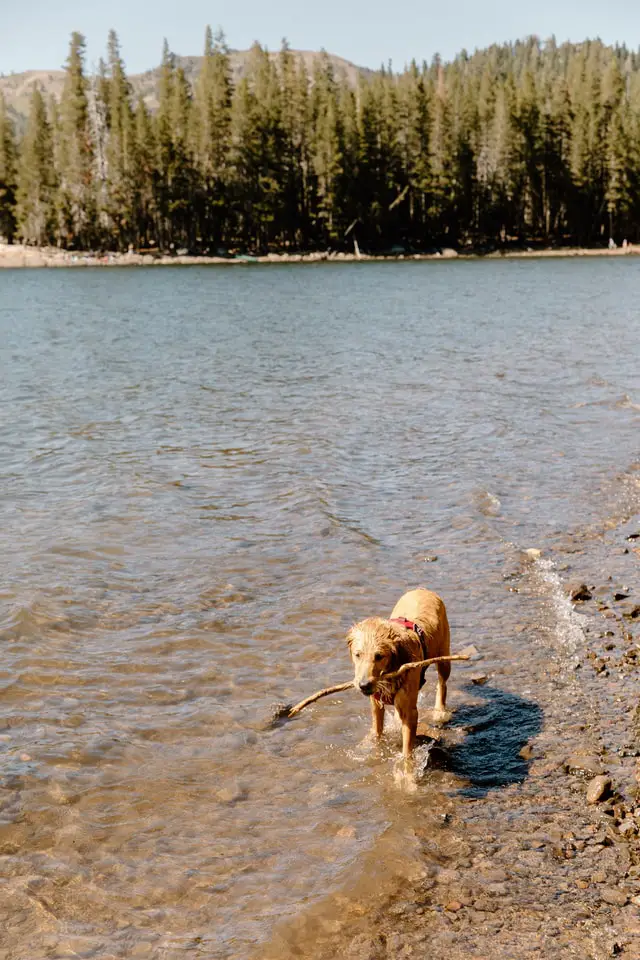
For those who want to chill at the lake…
- Biking
- Bird watching
- Boating
- Skiing
- Kayaking
- Canoeing
- Paddleboarding
- Sailing
- Swimming
- Camping
- Horseshoes
- Picnicking
- Hiking
- Gentle walking trails
- Nature photography trails
- Wildlife viewing
- Mountain biking
- Stargazing
- and most importantly… relaxing.
Other Arizona Related Fishing Articles
- Top 20 Best Places To Fish In Arizona 2023
- Interactive AZ Fishing Map 2023 – Where To Go Fishing In Arizona
- How much does a Arizona fishing license cost?
- Best Tackle Shops In Phoenix Arizona 2023
- Best Bass Fishing Lakes in Arizona 2023 (Voted by Local Anglers!)
- Alamo Lake Fishing Report 2025
- Apache Lake Fishing Report 2025
- Ashurst Lake Fishing Report 2025
- Bartlett Lake Fishing Report 2025
- Bear Canyon Lake Fishing Report 2025
- Big Lake Fishing Report 2025
- Blue Ridge Reservoir Fishing Report 2025
- Canyon Lake Fishing Report 2025
- Chevelon Lake Fishing Report 2025
- Kinnikinick Lake Fishing Report 2025
- Lake Havasu Fishing Report 2025
- Lake Mary Fishing Report 2025
- Lake Pleasant Fishing Report 2025
- Patagonia Lake Fishing Report 2025
- Rainbow Lake Fishing Report 2025
- Roosevelt Lake Fishing Report 2025
- Saguaro Lake Fishing Report 2025
- Show Low Lake Fishing Report 2025
- Sunrise Lake Fishing Report 2025
- Willow Springs Lake Fishing Report 2025
- Woods Canyon Lake Fishing Report 2025
More articles just for you...
Funny Fishing Rules, Laws, and Regulations 2025
Crazy Fishing Laws That Will Blow Your Mind! #7 is INSANE! Strange Fishing Regulations and Laws As silly as hook and rod limits may seem,
EXPOSED! How To Use A Spinnerbait The Right Way for 2025
Are You Wondering How To Use A Spinnerbait? Or How To Work A Spinnerbait Over Grass, Logs, or Points? Well, All These Questions Are Answered
EXPOSED! Best Crankbait Colors for 2025 [Which to Buy & Avoid]
What color crankbait to use? Crankbait Color Chart I just love going into a Bass Pro Shops store and just staring at all the walls
Best Underwater Dock Lights For Fishing – 2025 Buyers Guide
Night Dock Light Fishing For Beginners Dear fellow angler, Does this sound like you? You’re someone who loves fishing but just wants to escape the
15 Best Deep Diving Crankbaits [2025 Buyers Guide – Which to Buy & Avoid]
A Complete Buyer’s Blueprint On The Best Deep Diving Crankbaits for Bass, Walleye, or Striped Bass On The Market Today Fishing deep diving crankbaits can

